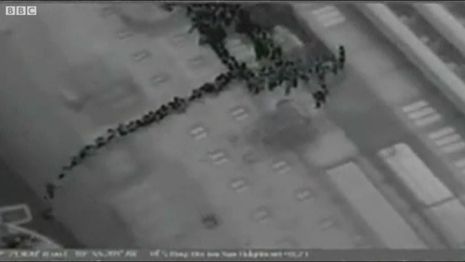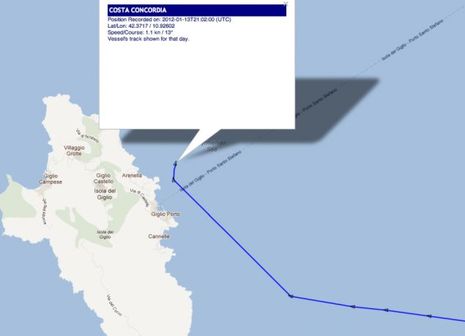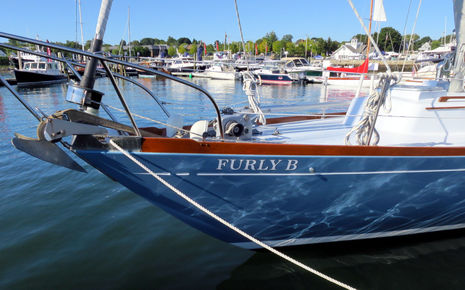Costa Concordia: “Vada a bordo, cazzo!”
The wrecking of the Costa Concordia is of course a dreadful and criminally unnecessary disaster. It’s hard to find anything positive about what happened, unless perhaps you’re another captain whose life became defined by a single major screw up, like, say, Joe Hazelwood. The Monitor did a good job delineating Capt. Francesco Schettino’s Top 4 ‘deceptions’ today and that was before Schettino made the claim that he abandoned ship because he tripped and fell into a lifeboat! I suspect that it will be a long time before anyone beats Schettino in the disgraced ship captain department…
If there has to be a marine disaster, I for one am glad it’s not one that can be knee-jerk blamed on modern marine electronics. The Concordia sinking seems to be all about cascading human errors, and, in fact, technology has been helpful in the aftermath. Example number one is the thermal imagery seen in that helicopter video above of passengers rappelling down the wreck’s hull into lifeboats. Thermal is amazing at distinguishing hot bodies from cold world, even in daylight, and must have been a big help to the rescuers trying to get those four thousand passengers and crew ashore.
And there’s little doubt that AIS will be useful in reconstructing the “accident” though I think it’s interesting how confusing the early reports were. The gCaptain, which has covered the story very well, at first published a number of scenarios that were obviously based on only partial AIS data. As extrodinarily incompetent as Capt. Schettino seems now, he did not try to drive his ship through a passage barely wider than its 36 meter beam. And as much as I appreciate Marine Traffic, the fragmentary AIS plot below surely suggests that the Concordia was at the very edge of its coverage.
I guess it’s good that folks are learning about AIS this way, but it would be even better if everyone understood that a Class A vessel going 15 knots like Concordia was transmits its position every 6 seconds, or about every 150 feet. Apparently Lloyd’s has better AIS coverage of this area and is now reporting that Concordia made a similarly close “show off” pass by Giglio last August, with company permission. It will be very interesting to see if the coming investigation finds fault with anyone beyond Schettino. Did he have obvious character defects that management should have noticed? Was the crew properly trained for situations like this? Was the cruise ship company sloppy about safety?
I also suspect that heroes will surface. Who, for instance, managed that pitch dark ant line down the side of the ship seen in the top image? And I’m happy for the Italians that one hero has already emerged in the form of Coast Guard Captain Gregorio De Falco, the man who told off Schettino in no uncertain terms. Apparently T-shirts printed with Falco’s angry admonition “Vada a bordo, cazzo!” are already selling briskly in Italy (and I’d be pleased to wear one). For the full meaning, I’ll have to send you here, but after that please share your thoughts on Costa Concordia. What’s to learn?
















This guy has single handedly tarnished the good title of Captain.
While foolish and other words may cover the initial actions of the Captain, I struggle to find the words for the captains action’s after the boat grounded, especially in announcing an “electrical problem”, waiting an hour to declare a Mayday, leaving the crew without leadership, and other actions that put the pax and crew in additional peril.
Honestly, it looks like Schettino is cracking up. He’s got facial ticks that would level a city. I’d like to see him under observation for his own safety.
I don’t know if “don’t be a [redacted]” counts as a lesson worthy of the loss of life.
More Interesting analysis from an ex sub captain here:
http://leader-leader.com/blog/
Italians are seeing this as a metaphor with Schettino as Berlusconi and the Concordia as the ship of state. Vada a bordo, cazzo! is being taken as an admonition to do your duty.
Can you imagine the feeling he had to have when they struck the reef and his entire career flashed in front of him? It could break even an otherwise good captain that under different circumstances would have acted differently during the aftermath.
But in this case, while the captain’s judgement appears poor to begin with, as this thread alludes to is why the system would ever allow the ship to pull such stunts at night with thousands of passengers on board. How pervasive is this? Are there other captain’s or other islands or other cruise ship lines doing the same thing?
On another note, does anyone know what the “tourist” system is that was referred to in some news articles?
My thoughts in order…
Is enough done to find and rescue the people that are trapped inside. For how long could a person survive inside under those conditions?
Next. Save the ship and prevent oil leakage.
How can a captain and second in command abandon more then 4000 souls? There are so many questions on how they acted after and before the accident.
Hopefully we will see all crusing ships train for disaster this week.
And off course in case of total electronic navigation failure. Look out the window, slow down and steer to safe water.
/Marcus
Costa is very eager to blame everything on the captain, and his actions (especially after the grounding) certainly don’t speak well for him. But there are the comments by passengers that the crew seemed disorganized and mostly did not help with the evacuation. Surely this is a common problem with today’s multi-national crews, but maybe it needs to be addressed better.
Then there is the strange story of an electrical/electronic collapse just before the grounding. Where were the redundancies? The director of RINA (the Italian classification society) has just resigned.
The captain committed major errors in judgment, but it seems that there is a pattern of mis-management, as well. You now have to wonder it this pattern is typical of the whole industry.
Michael Porter
http://www.mp-marine.com
“Cruise Captain Says He ‘Tripped’ Into Lifeboat, Couldn’t Get Out”. To get a Masters License you have to pass a series of exams and have the requisite experience. There is no check ride exam. To get a drivers license or a pilots license you need to pass a check ride exam. This guy is an embarrassment to us who take being the captain seriously and have a deep sense of responsibility for the safety of both the vessel and all personnel on board. If you screw up you take responsibility, minimize the damage, and protect the passengers and crew. You don’t have to go down with the ship, but you need to be the last one off.
Patrick Harman
It may be better to reserve judgment until all the facts are in, including the information from the vessel’s VDR.
The last AIS track recorded
http://www.youtube.com/watch?feature=player_embedded&v=s5mbKt7rQkQ
Thanks, Jugo! That track appears to use all or almost all the AIS data that the Costa Concordia was transmitting. And there’s a higher resolution version at the QPS site: http://goo.gl/png59
In this data you can almost see the ship bounce off the rocks, but what gave me a chill was the thought of her sinking in deep water. Could she have turned turtle before sinking? Could there have been an enormous loss of lives?
The track shows the ship crabbing into shallow water, which could be just a heading sensor error in the data or could have been a smart way to get her grounded. As Norton notes, the ship’s black box may reveal more, as will interviews with everyone involved.
Apparantly it is not uncommon to operate Cruise ships close to shore. The QE 2 touched botttom off Cutty Hunk while running at 25kts in 40 feet of water. She draws 32.4. See link here
http://www.hydro-international.com/issues/articles/id1093-Grounding_of_the_Queen_Elizabeth__response.html
In the end they found an uncharted rock with bottom paint on it, not surprising given the age of our coastal surveys.
What was surprising, to me at least, is that she was running with such a small margin of error. The equivalent in my sailboat with a 5 ft draft would be 6.25 ft. depth. I dont think I would plan a passage that close to shore. At least not if there were alternatives.
My take is that the course had not been plotted with any way points etc, the Captain was simple following a compass heading. Unfortunately it became apparent that the ship was too far to the west and a hasty turn to starboard was made. Notice there is no damage to the port stabiliser, the ship made a rapid turn to starboard swinging the stern into the rocks.
It appears that the power went off several minutes after the collision, with that size of gash certainly one generator compartment would be inundated.
Whether she would have turned over in deep water is questionable, in taking her in to shallow water, with a rocky and not necessarily flat bottom, that could have punch holes in other compartments. So far they have been extremely lucky with fuel oil.
Tedgo
an educated talk radio show about this event: http://onpoint.wbur.org/2012/01/20/sea-captains
Thanks, X; I’m listening now and Tom Ashbrook seems to have done a great job putting the show together. There are also very interesting thoughts about the way the ship flooded in the WBUR comment section from “CaptMJR”…we have lots left to learn about the wreck of the Costa Concordia.
PS There is now a story that Schettino hit the rock while showing off to a “pretty young blond” who was somewhat mysteriously on the bridge with him. Oy!
Anyone do the basic research yet ?
– What was the set and drift at the time of the initial impact and the grounding?
– when was high tide / low tide that day?
Any facts on the following ?
– was the current a factor in the ship hitting the island initially ?
– was the current a factor in assisting the ship in grounding as gcaptain speculated, or was the stern thrusters functional in addition to the bow thrusters?
– the deck plan of the lower levels?
– information from the ships black box?
Anyone make guesses yet at ?
– which compartments were flooded by the original impact?
– simulation of the flooding of those compartments?
Have you done any research, Dan? Here’s another copy of the AIS track Jugo commented on above, this one narrated by Jon Konrad of gCaptain.
http://goo.gl/vfMG5
There are definitely still uncertainties, but it’s very hard to see how tide or current could be considered factors in the initial collision with the ledge. Not when the ship was driven straight toward the rock at 15 knots for no good reason.
I have not done any basic research, but I do follow the news with a lot of interest.
I have read (or watched) all the material in gCaptain up thru thursday night.
In one of the Wednesday/Thursday? gCaptain video’s there was a guess that there was current helping the stern of the ship as the bow thrusters helped crab the ship to shore.
If that was the case, it would help explain how the ship hit the island initially without damaging the stabalizer, and it might also not have helped, but rather hurt the short trip towards shallow water. Ideally the ship would have head bow first into shallow water, but perhaps the current prevented that.
From court testimony during his arraignment,we now know a lot more. The captain was taking the ship in for a “bow” which has been done before (as recently as 6 months ago)when it was authorized. The “bow” was to honor a retired commodore of the line. The previous track, available from Lloyds may actually be closer to the island. On that subject, I’m mystified. One translation has the captain saying that he guided the ship by intuition. He says that he knows those waters. Then why does he say that he hit an uncharted rock?
Ben, you asked who was responsible for getting people off since the ship’s officers had departed. So far, I have identified the courageous Deputy Mayor of the village. He looks young and strong. He went on board and directed some part of the evacuation. The Port Captain said that he had an air rescue team on board forward. In addition, the Purser remained and directed part of the rescue. At some pointy he broke his leg and was one of the last to be evacuated (by helicopter). When asked why he remained, he said, “It was my duty.” The big difference in rescue methods seems to be that the Italians do not appear to have many helicopters with hoists for rescue. We know that South Africa, Great Britain, and the U.S. rely upon this method. The Italians had no shortage of boats, however.
The amount of lying is somewhat incredible. When speaking to the ship’s captain, the Port Captain said that no one on the ship was answering the VHF. BTW, there is a law in Italy making it illegal for a captain to leave his ship before the last passenger and crewman has departed. Several nations have this law.
Regardless of the blonde, Moldavian translator, the captain was on the bridge and was in control. He may have been eating dinner with her immediately before. I believe her to be a liar. Some have mention that he was drinking wine, but it’s a different culture. My Al Italia flight crew had wine served to them in the cockpit!
After the deaths, the next hazard is the fuel on board. If that escaples, a marine preserve will be destroyed.
“The previous track, available from Lloyds may actually be closer to the island. On that subject, I’m mystified.”
Me too, Ron. If the QPS track referenced several times above is accurate, and it sure looks credible, you can’t really get a ship closer to those rocks. And if a previous track was very close to that danger, as Lloyds reports, why didn’t the shipping company put a decisive end to such showboating?
I actually have no problem with “bowing” to Giglio, but can’t see why it had to include such a close pass of the rocky point at 15 knots.
Of great interest to me is the ship’s stability. I’m gathering that it started to heel badly in deep water, but Jon Konrad is saying that putting it aground was a big mistake: http://goo.gl/HqwWV
i looked up on my charts the coords where divers found the orig rocks he hit
N 42 21.333 E 10 55.833
and there is a well marked contour of 7 meters around there
draught of the concordia is 8.2 meters
(FYI no significant tides in that region of med.)
collision on youtube video above can be seen at 0:49 on the video
15 knots, turned too late
natch, slowing down would have been an idea
but at that speed, if the turn had been initiated 5 or even 3 minutes earlier
they would have still been 0.5 to 1 mile (not very much for a ship that size!) away from Giglio village
which would have been well close enough for a “sail by”
a shame
simply should have never happened.
All I can say is that I would love to be a fly on the wall when the investigating authorities are reviewing data drom the voyage data recorder…it can tell no lies.
No current, Thank’s Tim!
That’s interesting.
(1) Current wasn’t a contributing factor in misjudging the turn.
(2) When she crabbed sideways after the accident seeking shallow water, her rear thrusters may have had power as well as the bow thrusters. (In gCaptain it was an early theory that all rear propulsion was lost), and the current helped the boat crab sideways on bow thrusters alone.)
G’Day Ben,
I’m interested in stability too, and I wonder why the ship ended with the damaged side high in the air.
My opinion, based on ship stability training practices, goes something like this.
When the ship hit the rocks, somebody panicked and flooded the ballast tankage on the far side from the damage in an attempt to keep her on an even keel, or possibly to try and lift the damaged clear of the water. Instead, what happened was that as the ship’s trim was overcorrected, the incoming water flooded to the ballasted side and the ship “flipped”, and heeled over a long long way.
Circumstantial evidence for this being the case:
1. The senior crew appear to have abandoned early, no one left in charge of ballasting, or knew how to do it properly to stop the flip effect.
2. The reports among survivors of the boat heeling fast, and broken bones from falls as the decks became walls.
It’s just a theory… It’ll be interesting to see what comes out in the inquiry.
Cheers,
Mike.
It might help to know that the ship was a twin screw, controllable pitch, diesel electric. She has a sister ship and Carnival is basing a slightly larger version on this design. She will be built in the USA – supposedly. There was one comment that the “water rushed from the torn side to the starboard side.” With the loss of all those generators, you have to wonder what power was available to drive ballast pumps? Many ships have the thruster system powered independently at each thruster.
It appears that the ship handling error was akin to that of the Exxon Valdez. Not one bridge officer has stood by the captain. One officer has testified that the ship had made similar close passes on the previous 3 voyages. You would think that someone would have entered waypoints for such passes. Perhaps it is only in warships, but the design could have incorporated a longitudinal bulkhead dividing the engine room in two.
It sounds good to say wait for the facts before reaching a judgement, but the testimony of the captain himself is bad enought, but the other ships officers on the bridge say that he lost it and began pacing back and forth. Then he issued the order to make a VHF call about temporarily losing power, The other officers testified that he next ran to his cabin where he got his laptop and then made for the boats.
Look, maybe not many of you have been in the military or been in a crisis; but that is when true leadership shows. The leader must be calm in an emergency, gather information, and take action to save the unit or save the ship or plane. Surely the meaning of leadership should have been impressed upon you by the example of the pilot who landed his plane in the Hudson River. Amongst many things he did right, the last thing was to wade aft up to his chest in water to check for trapped passengers and crew. There was one person making her way forward using the tops of the seats. Then, and only them did he step up into a life raft. Later, he occupied himself pouring over the manifest and checking the different landing sites to account for all his charges.
That is what captains do. Anything short of that by an uninjured captain is dereliction of duty. BTW, the divers announced that the Moldavian woman’s clothing was found in the captain’s cabin. She had purchased a ticket, but had no cabin assigned. That doesn’t make him a bad ship-handler, but it sure reflects on his character. I would be surprised were his wife to again spring to his defense.
One US admiralty attorney has suggested that there are close ties between businessmen like the cruise line executives and the Italian justice system and their political figures. We aren’t too much better. However, please note the spigot of information has been turned-off. The black box was read on the Wednesday following the accident. As someone pointed-out in one of the articles that Ben has referenced, the investigation must not stop with the captain. The author suggested that this is more than a singular incident and points to the confused behavior of the crew. The cruise line set the stage for this disaster. Oh, and I’d like to see the stability calculations for such a shallow draft ship with so many decks. Many cruise ships appear to share this wedding cake design.
If you can’t be a fly on the wall in Italy, you could watch The Caine Mutiny DVD (1954) with Humphrey Bogart as the captain who doesn’t have the right stuff.
http://www.imdb.com/title/tt0046816/
Geez, Ron, I don’t think anyone commenting here needs a lecture on how a responsible captain acts. But in my experience the wiser and more experienced a skipper is, the more careful he or she is about judging others. For sure, it’s getting pretty obvious that Schettino is an arrogant fool who failed in many ways, but the subtler lessons of this didn’t-have-to-happen sinking won’t be understood until all the facts are in.
Luxurious French yacht sank in Greece
I just read a short article on a major Swedish newspapers site that says a yacht has sunken in Greece. This might not be the right place to post this but as this thread is about sinking ships in the Mediterranean I guess it is, in a way.
This is a layman’s quick translation of the Swedish article:
“Five had to be salvaged before French Yacht sank to bottom
The 60 meter long luxury yacht Yogi sank before the eyes of the rescue team. All eight on board got off with no more than a fright.
It was early this morning when the captain on the French registered luxurious yacht sent out a distress call (alarm). The yacht was located outside the Greek island of Skyros. Two helicopters responded and succeeded in rescuing everyone on board the yacht. A lot of other boats also came to rescue.
Sank quickly
It was not possible to salvage the yacht. It sank just after the passengers were lifted up to the helicopters, according to AP. Nobody was hurt.
According to the captain the ship had gotten a mechanical error and therefore started to lean to one side due to hard winds.”
Here’s the Swedish article (with a few pictures):
http://www.aftonbladet.se/nyheter/article14392613.ab
Here’s a video from one of the rescue helicopters on the French newspaper Le Monde’s site:
http://www.lemonde.fr/societe/article/2012/02/18/le-mega-yacht-de-stephane-courbit-a-fait-naufrage_1645340_3224.html
Vanity Fair has a pretty detailed synopsis of what happened on the Costa Condordia. There’s nothing from the official investigation yet, but it may be that her track after hitting the ledge was all wind and current, no propulsion involved. It seems like the best that can be said of Capt. Schettino was that he was in shock:
http://goo.gl/JCWmT
Streaming live coverage of the Costa Condordia salvage operation from the Swedish national television:
http://www.svtplay.se/video/1466539/bargningen-av-m-s-costa-concordia
The site says that it is viewable globally (compared to yesterday when it was only viewable in Sweden).
They’ve gotten her up from the bottom. What an effort!
This works:
http://www.youtube.com/watch?v=MbAZs2flOPQ